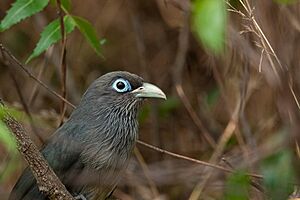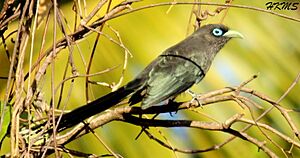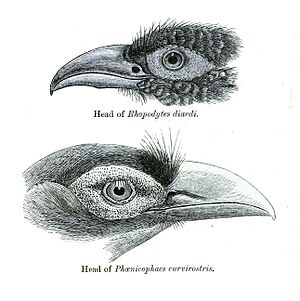Blue-faced malkoha facts for kids
Quick facts for kids Blue-faced malkoha |
|
|---|---|
 |
|
| Blue-faced Malkoha from Mysore, Karnataka, India | |
| Conservation status | |
| Scientific classification | |
| Genus: |
Phaenicophaeus
|
| Species: |
viridirostris
|
The blue-faced malkoha (Phaenicophaeus viridirostris) is a special type of cuckoo bird. Unlike some cuckoos, it does not lay its eggs in other birds' nests. You can find this bird in the forests of India and Sri Lanka.
This malkoha has dark, blue-grey feathers on its back. It has a long tail with white tips on its feathers. Its throat and chin are dark with pale, spiky-looking feathers. The lower part of its belly is a light creamy or reddish-brown color. A bright apple-green beak and a patch of blue skin around its eye make it easy to spot. Male and female blue-faced malkohas look very much alike. They prefer to live in open forests and scrublands.
Contents
What Does It Look Like?
The blue-faced malkoha is a fairly large bird, about 39 centimeters (15 inches) long. Its head and back are dark grey with a shiny green or blue look. Its dark tail feathers have white tips. The belly is a light yellow-brown or grey color.
The feathers on its chin and throat are unique. They have pointed, yellowish tips, which makes the throat look streaky. Around its eye, there is a large patch of blue skin. Its eye has a red center with a white edge. The beak is a bright apple green.
Male and female birds look the same on the outside. Malkohas from Sri Lanka have wider white tips on their tail feathers. These birds are usually quiet. However, they might make a low, croaky kraa sound if they are startled. Young malkohas have duller feathers and some brown on their wings.
Where Do They Live?
The blue-faced malkoha lives in peninsular India. This area is south of cities like Baroda and Cuttack. They live in different types of forests. These include semi-evergreen, dry deciduous, and open scrub forests. In Sri Lanka, they are only found in the flat plains. These birds have been seen in the Trichy district of Tamil Nadu, India.
Reproduction and Life Cycle
Blue-faced malkohas build their nests inside thorny bushes. They make a thick platform using twigs. They line the nest with green leaves. The female usually lays two, or sometimes three, chalky white eggs.
The breeding season for these birds is quite long. Nests have been found from March to August.
How Do They Find Food?
The blue-faced malkoha eats many different things. Their diet includes various insects and caterpillars. They also eat small vertebrates, which are animals with backbones. They usually look for food in the lower plants and bushes.
Scientific Name and History
A scientist named T.C. Jerdon first described this bird in 1840. He found a specimen near the Coonoor ghats in India. He thought it was similar to birds in the Phaenicophaeus group.
The blue-faced malkoha is now part of the Phaenicophaeus group. This group is a type of cuckoo. Scientists study birds' bodies to understand how they are related. One study looked at the blood vessels in birds. It found that this malkoha has special blood vessels in its neck.




